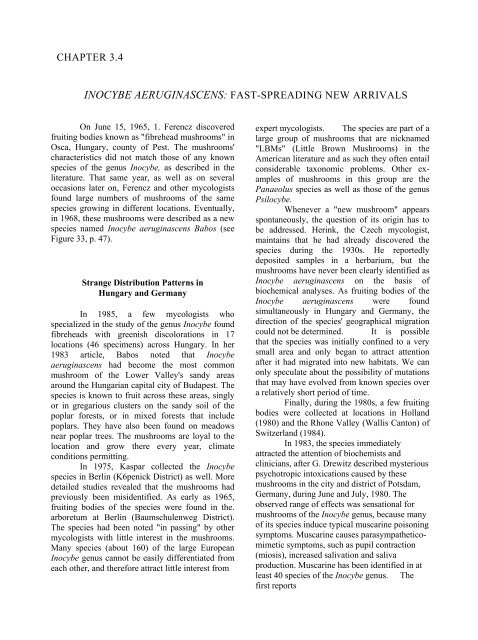Jochen Gartz - Magic Mushrooms Around the ... - preterhuman.net
Jochen Gartz - Magic Mushrooms Around the ... - preterhuman.net
Jochen Gartz - Magic Mushrooms Around the ... - preterhuman.net
You also want an ePaper? Increase the reach of your titles
YUMPU automatically turns print PDFs into web optimized ePapers that Google loves.
CHAPTER 3.4<br />
INOCYBE AERUGINASCENS: FAST-SPREADING NEW ARRIVALS<br />
On June 15, 1965, 1. Ferencz discovered<br />
fruiting bodies known as "fibrehead mushrooms" in<br />
Osca, Hungary, county of Pest. The mushrooms'<br />
characteristics did not match those of any known<br />
species of <strong>the</strong> genus Inocybe, as described in <strong>the</strong><br />
literature. That same year, as well as on several<br />
occasions later on, Ferencz and o<strong>the</strong>r mycologists<br />
found large numbers of mushrooms of <strong>the</strong> same<br />
species growing in different locations. Eventually,<br />
in 1968, <strong>the</strong>se mushrooms were described as a new<br />
species named Inocybe aeruginascens Babos (see<br />
Figure 33, p. 47).<br />
Strange Distribution Patterns in<br />
Hungary and Germany<br />
In 1985, a few mycologists who<br />
specialized in <strong>the</strong> study of <strong>the</strong> genus Inocybe found<br />
fibreheads with greenish discolorations in 17<br />
locations (46 specimens) across Hungary. In her<br />
1983 article, Babos noted that Inocybe<br />
aeruginascens had become <strong>the</strong> most common<br />
mushroom of <strong>the</strong> Lower Valley's sandy areas<br />
around <strong>the</strong> Hungarian capital city of Budapest. The<br />
species is known to fruit across <strong>the</strong>se areas, singly<br />
or in gregarious clusters on <strong>the</strong> sandy soil of <strong>the</strong><br />
poplar forests, or in mixed forests that include<br />
poplars. They have also been found on meadows<br />
near poplar trees. The mushrooms are loyal to <strong>the</strong><br />
location and grow <strong>the</strong>re every year, climate<br />
conditions permitting.<br />
In 1975, Kaspar collected <strong>the</strong> Inocybe<br />
species in Berlin (K6penick District) as well. More<br />
detailed studies revealed that <strong>the</strong> mushrooms had<br />
previously been misidentified. As early as 1965,<br />
fruiting bodies of <strong>the</strong> species were found in <strong>the</strong>.<br />
arboretum at Berlin (Baumschulenweg District).<br />
The species had been noted "in passing" by o<strong>the</strong>r<br />
mycologists with little interest in <strong>the</strong> mushrooms.<br />
Many species (about 160) of <strong>the</strong> large European<br />
Inocybe genus cannot be easily differentiated from<br />
each o<strong>the</strong>r, and <strong>the</strong>refore attract little interest from<br />
expert mycologists. The species are part of a<br />
large group of mushrooms that are nicknamed<br />
"LBMs" (Little Brown <strong>Mushrooms</strong>) in <strong>the</strong><br />
American literature and as such <strong>the</strong>y often entail<br />
considerable taxonomic problems. O<strong>the</strong>r examples<br />
of mushrooms in this group are <strong>the</strong><br />
Panaeolus species as well as those of <strong>the</strong> genus<br />
Psilocybe.<br />
Whenever a "new mushroom" appears<br />
spontaneously, <strong>the</strong> question of its origin has to<br />
be addressed. Herink, <strong>the</strong> Czech mycologist,<br />
maintains that he had already discovered <strong>the</strong><br />
species during <strong>the</strong> 1930s. He reportedly<br />
deposited samples in a herbarium, but <strong>the</strong><br />
mushrooms have never been clearly identified as<br />
Inocybe aeruginascens on <strong>the</strong> basis of<br />
biochemical analyses. As fruiting bodies of <strong>the</strong><br />
Inocybe aeruginascens were found<br />
simultaneously in Hungary and Germany, <strong>the</strong><br />
direction of <strong>the</strong> species' geographical migration<br />
could not be determined. It is possible<br />
that <strong>the</strong> species was initially confined to a very<br />
small area and only began to attract attention<br />
after it had migrated into new habitats. We can<br />
only speculate about <strong>the</strong> possibility of mutations<br />
that may have evolved from known species over<br />
a relatively short period of time.<br />
Finally, during <strong>the</strong> 1980s, a few fruiting<br />
bodies were collected at locations in Holland<br />
(1980) and <strong>the</strong> Rhone Valley (Wallis Canton) of<br />
Switzerland (1984).<br />
In 1983, <strong>the</strong> species immediately<br />
attracted <strong>the</strong> attention of biochemists and<br />
clinicians, after G. Drewitz described mysterious<br />
psychotropic intoxications caused by <strong>the</strong>se<br />
mushrooms in <strong>the</strong> city and district of Potsdam,<br />
Germany, during June and July, 1980. The<br />
observed range of effects was sensational for<br />
mushrooms of <strong>the</strong> Inocybe genus, because many<br />
of its species induce typical muscarine poisoning<br />
symptoms. Muscarine causes parasympa<strong>the</strong>ticomimetic<br />
symptoms, such as pupil contraction<br />
(miosis), increased salivation and saliva<br />
production. Muscarine has been identified in at<br />
least 40 species of <strong>the</strong> Inocybe genus. The<br />
first reports








![The Big Lie 9-11 and Government Complicity in Mass Murder [PDF]](https://img.yumpu.com/50957077/1/190x245/the-big-lie-9-11-and-government-complicity-in-mass-murder-pdf.jpg?quality=85)








